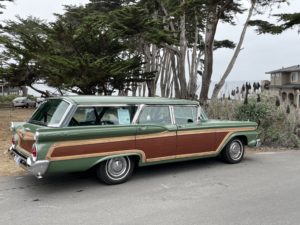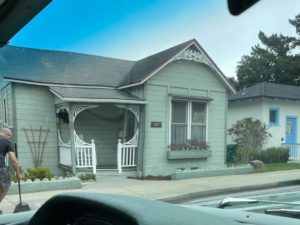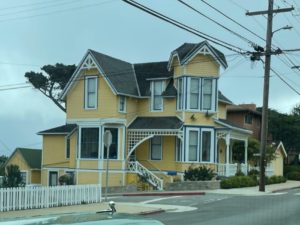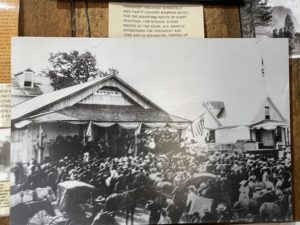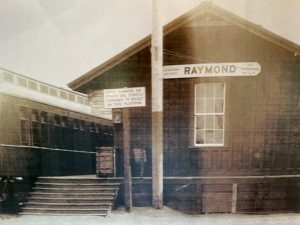In which Sid, Doris and JGG leave sea level for a 5,000 foot climb in rather over 100 degrees F.
We say good bye to the Pacific and trundle out past self-consciously pretty Pacific Grove houses. We’ve seen a lot of painted clapboard on the east and west coasts, now it’s time to see how they build houses on the places in between.
 Straight roads are not as easy as long curves for the JGG and Doris notices the minute but constant adjustments to the steering wheel. [Identified in Tonopah as a possible tracking problem – S.] We climb up from the irrigated coastal plain to spend a long time going through the flat irrigated central plain. It is hard to see how Kansas can be more dull. Maybe just longer?
Straight roads are not as easy as long curves for the JGG and Doris notices the minute but constant adjustments to the steering wheel. [Identified in Tonopah as a possible tracking problem – S.] We climb up from the irrigated coastal plain to spend a long time going through the flat irrigated central plain. It is hard to see how Kansas can be more dull. Maybe just longer?
Sid and Doris love -ests and similar claims and here is Castroville, “Artichoke center of the world”. Then the crops change from cherries and apricots to pistachio and almonds, all very water-hungry.
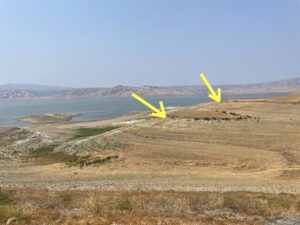 Gradually we gain height to find the huge San Luis Reservoir where we go to see the Visitor Center. It is shut but luckily Sid and Doris get chatting with a guy who works for Livermore Water. The reservoir is now 8% full and was last really full 4 years ago. [I have marked the previously-usual high water level with yellow arrows – D.] He tells us that Central Californian irrigation district is one of the largest man made changes to a landscape. He uses the height of a telegraph pole by the side of a bridge as a guide to how far aquifer depletion has dropped the land.
Gradually we gain height to find the huge San Luis Reservoir where we go to see the Visitor Center. It is shut but luckily Sid and Doris get chatting with a guy who works for Livermore Water. The reservoir is now 8% full and was last really full 4 years ago. [I have marked the previously-usual high water level with yellow arrows – D.] He tells us that Central Californian irrigation district is one of the largest man made changes to a landscape. He uses the height of a telegraph pole by the side of a bridge as a guide to how far aquifer depletion has dropped the land.
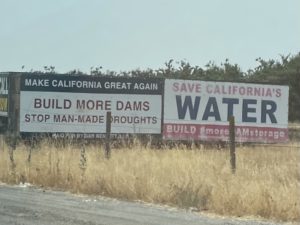 In farming country we see many posters Build more dams! We see them outside contractors’ yards too.
In farming country we see many posters Build more dams! We see them outside contractors’ yards too.
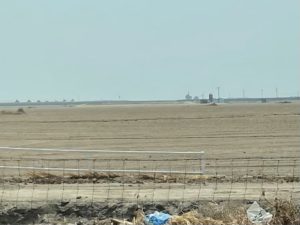
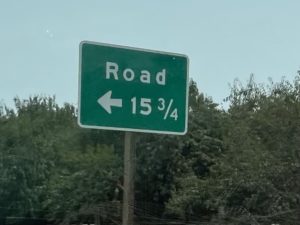 Everyone seems to have lost interest in this countryside – even the road namers have run out of inspiration. We are getting very thirsty. The outside temperature is about 100. We try the aircon but the extra power required puts the engine temperature over 200 so when we stop at a junction the fuel boils and the engine stops. We are plugging on through the fields thinking “surely there must be a more usual way to get to Yosemite” and are very glad to find Mr Google suggesting Las Patronaz Bar as the only cafe on the route.
Everyone seems to have lost interest in this countryside – even the road namers have run out of inspiration. We are getting very thirsty. The outside temperature is about 100. We try the aircon but the extra power required puts the engine temperature over 200 so when we stop at a junction the fuel boils and the engine stops. We are plugging on through the fields thinking “surely there must be a more usual way to get to Yosemite” and are very glad to find Mr Google suggesting Las Patronaz Bar as the only cafe on the route.

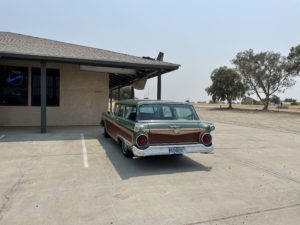 And they are pleased to see us. Two Cokes, two dollars. (Not the same in Monterey.) Turns out that this is the route that Google suggests for everyone so they have seen Brazilians, French and Chinese. We are not far from Google HQ… has there been some gentle manipulating of information?
And they are pleased to see us. Two Cokes, two dollars. (Not the same in Monterey.) Turns out that this is the route that Google suggests for everyone so they have seen Brazilians, French and Chinese. We are not far from Google HQ… has there been some gentle manipulating of information?
We have seen posters advertising Pomegranate wine and ask if anyone but tourists would drink it. Oh, yes, mighty fine stuff. In fact we have a Pomegranate Festival and not just wine. Maybe juice? Pomegranate juggling? Miss Pomegranate? We are reminded of the Liwa Date Festival in the UAE.
Not long after we see a sign to a Historic Site 7 miles. At about seven miles we pull into a small memorial park, drive around mystified and drive on. A half mile later we see a caboose on a few yards of rail and the JGG pulls off the road in a cloud of dust outside the old town station building. We are on the outskirts of Raymond, a tiny town formed around the place where the railroad ended and journeys to Yosemite by horse drawn coach began. Two trains a day, like being at Mallaig, though the rails came up in Raymond in the 1940s.
The museum is run by a lady rancher who does not eat the bun with her burger. She tells us the tale of the railway, the man who was station-agent and post-master. We see his house, the bed where he died before he was wed, his kitchen and office. The whole place is covered in pictures. Naturally we are shown into the caboose and the artifacts that had been taken from the railway when it closed, then found and returned. Like the floor from someone’s kitchen that had been part of the station signboard, and the original “Raymond” sign from the photo above that someone had stolen and insisted on donating anonymously in case the statute of limitations did not apply to railway signs.
 We are also shown the local super dense white granite and a saw for cutting it (“The oldest granite saw this side of the Mississippi”). White granite was used to build LA City Hall, a fine building finished in 1928. So, a lot of sawing and much traffic for the railway.
We are also shown the local super dense white granite and a saw for cutting it (“The oldest granite saw this side of the Mississippi”). White granite was used to build LA City Hall, a fine building finished in 1928. So, a lot of sawing and much traffic for the railway.
We spend a happy hour with the rancher-lady, her husband, someone else’s husband, a recent widow and All Rabbit’s Friends and Relations. She nearly calls a local mechanic but we fight that off.
We are climbing up to 5,000 feet on a hot day in a car that has never seen a rolling road. The car is hot. Sid and Doris are hot, often pulling over to let normal traffic past. We drop down onto our hotel Wawona at about 4,000 feet. Coming down is better than going up.
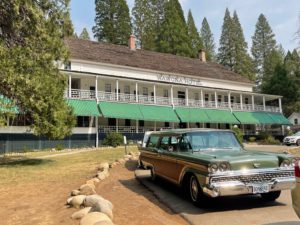
 Wawona was founded in 1857 by Galen Clark who built a house half way between Mariposa and Yosemite Valley. That house was superseded by the current main hotel building soon after to take in adventurous tourists and painters. Over the following 40-60 years newer blocks were built in similar style, and many of the rooms still don’t have private bathrooms, with very nicely-painted communal loo and shower facilities. But Sid and Doris have got the last room available in the original building which is so authentic their room also has no windows.
Wawona was founded in 1857 by Galen Clark who built a house half way between Mariposa and Yosemite Valley. That house was superseded by the current main hotel building soon after to take in adventurous tourists and painters. Over the following 40-60 years newer blocks were built in similar style, and many of the rooms still don’t have private bathrooms, with very nicely-painted communal loo and shower facilities. But Sid and Doris have got the last room available in the original building which is so authentic their room also has no windows.
Galen Clark became a conservationist and promoted the Federal legislation to protect the countryside (for tourism). Early tourists could get from San Francisco to Yosemite by river to Merced and then by horse to Mariposa. In 1886 the railway to Raymond knocked 3 1/2 hours off the journey from Madera to Wahona though there was still plenty of jolting about in a carriage with leaf springs and poor damping. (Does that remind you of anything?)
President Theodore Roosevelt was a key figure in the creation of national parks. He made the journey and stayed in the Wahona Hotel, dining with naturalist John Muir here in 1903. Other visitors: Ralph Waldo Emerson (poet), Sir Arthur Sullivan (doggerel with music), Eleanor Roosevelt (in 1940) and Sid and Doris.
